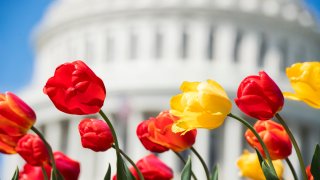
What to Know
- Washington, D.C., will require that all of its electricity come from renewable sources by 2032, the most ambitious timetable in the country
- Hawaii and California have committed to 100 percent clean energy by 2045
- The Fourth National Climate Assessment has outlined the real-time effects of climate change across the U.S.
As the Trump administration moves to dismantle federal laws to curb greenhouse gas emissions, Washington, D.C., is working to bring renewable energy to the White House and the rest of the city.
Under a law approved in December, the District of Columbia will require that all of its electricity come from renewable sources by 2032, the most ambitious timetable in the country. Federal buildings would be included.
"It’s doable, it works, it’s not some pie-in-the-sky idea," said Mark Rodeffer, the chairman of the Sierra Club’s Washington, D.C., chapter, which backed the law. "In 13 years, the U.S. Capitol is going to be powered by electricity that is 100 percent from wind and solar. At the same time, some climate deniers in the Capitol are going to be saying this is impossible to do, but they’re going to be saying that under lights that are powered by wind and solar, disproving the argument that they’re making."
Get a weekly recap of the latest San Francisco Bay Area housing news. Sign up for NBC Bay Area’s Housing Deconstructed newsletter.
Washington, D.C., has the tightest deadline, but it follows the lead of Hawaii and California, both of which earlier committed to 100 percent clean energy by 2045. Hawaii, the most petroleum-dependent of the 50 states, acted in 2015 and California, a leader in environmental advances, voted last fall. More than 100 cities also have pledged to move to completely clean, renewable energy, and a half a dozen smaller ones have already reached that goal, according to the Sierra Club.
Cities account for more than three-quarters of primary energy use but also are the most vulnerable to power disruptions linked to climate change, notes C40 Cities, a network of the world’s mega-cities that are addressing climate change. Ninety percent of all urban areas are on a coast, at risk from flooding from rising sea levels and powerful storms. Seventy percent of cities are already seeing the effects of climate change.
When Donald Trump was elected president, questioning whether climate change was real and promising he would gut attempts to cut carbon emissions, officials looked for ways to keep environmental progress headed forward. Absent a strong federal presence, cities, states and companies have taken the lead.
One of Trump’s early policy decisions as president was to withdraw the United States from the Paris Agreement, a worldwide attempt to confront climate change. In response, D.C. has banded together with New York, Los Angeles and other C40 cities to meet the agreement's goals — primarily to keep the global temperature increase this century to below 2 degrees Celsius above pre-industrial levels, and to try to limit the temperature rise even further to 1.5 degrees Celsius.
"Tying the work that we do in our city to other cities and what we do as a nation is hugely important," Washington D.C.'s mayor, Muriel Bowser, said this week. "We must also always keep in mind how we can close income gaps, promote economic and environmental justice in the work that we do."
U.S. & World
"But until our entire nation is moving in the same direction we take our local responsibility to build a greener and more sustainable city and a future city even more seriously because we’re acting on the local level, almost alone," she said.
The Clean Energy D.C. Act of 2018 is expected to cut emissions in half by 2032. By 2041, 10 percent of the electricity must come from solar facilities located in the District of Columbia or within the area of the regional transmission organization that serves the District, PJM Interconnection. PJM Interconnection coordinates the movement of wholesale electricity in the District, Maryland, Virginia and all or parts of 11 other states.
The aim is to make the city carbon neutral by 2050.
"The residents of Washington, D.C., expect local government to provide leadership to mitigate global warming," said Tommy Wells, the director of the District’s Department of Energy and Environment.
The act also encourages the purchase of electric vehicles and requires that all public transportation and privately owned fleet vehicles to become emissions-free by the year 2045.
It strengthens energy efficiency standards for new and existing buildings, which account for 74 percent of Washington D.C.'s greenhouse gas emissions. The District is the first jurisdiction to mandate buildings meet energy performance standards, which will be based on federal energy efficiency criteria, Wells said. Within five years every building must create a plan for meeting the standards, or the District will impose one. A green energy bank, funded with up to $100 million, will help multi-family buildings with affordable housing, he said.
The new requiremens are meant to bring additional, clean energy production online -- solar and wind though not nuclear power and hydropower -- and to move the district's electricity supplier away from purchasing energy credits in favor of long-term contracts.
"It’s a matter of supply and demand," Rodeffer said. "People will build more wind and solar farms because the demand is increasing. So that will expand renewable energy production, which is what this is all about."
Activists are hoping other municipalities and states will follow the lead of the nation’s capital. Maryland’s General Assembly passed a bill earlier this month that mandates half of the state’s electricity supply comes from renewable sources by 2030. Republican Gov. Larry Hogan vetoed a similar bill in 2016, but Democrats overrode his veto to set the current goal of 25 percent. Maryland’s secretary of the environment, Benjamin Grumbles, said this week that the governor’s office was reviewing the new bill.
Since California passed its 100 percent renewable electricity standard last year, at least nine states, including Connecticut, Illinois, Maine and New York, were considering similar proposals, The Los Angeles Times noted. The biggest challenge facing California is its reliance on natural gas.
Renewable energy now provides just a small percentage of electricity to customers who get their electricity from D.C.'s primary electricity supplier, Pepco Holdings -- which is about 84 percent of its 308,000 customers. The remainder purchase their energy through an alternative supplier.
For the first six months of last year, renewable energy was the source of just 5.8 percent of the District's electricity. Renewable energy credits, certificates that can be traded, made up the difference of a 16.5 percent renewable requirement.
The source of most of the District's electricity was nuclear at 35.3 percent, followed by coal at 29.8 percent, natural gas at 28.7 percent, and oil at 0.3 percent.
"We’ve been taking the stand for a long time now that climate change is real, we have to act, we have to act urgently, and we have to use all available carbon-free technologies that we have at our disposal today and we should be creating policies that encourage innovative and that allow us to take advantage any new carbon-free technologies that develop tomorrow," said Pepco’s senior vice president of governmental and external affairs, Melissa Lavinson.
"Our focus is on carbon and carbon reduction, what investments are needed, what can we do, what can others do and how can we work together to most expeditiously and affordably achieve our climate change goals."
The need to act was heightened by last year’s report from the United Nations scientific panel on climate change, which warned that the immediate consequences would be much worse than thought. The report, the first commissioned under the Paris agreement, describes wildfires, a mass die-off of coral reefs and food shortages if the world’s economy was not changed at an unprecedented speed.
The Fourth National Climate Assessment, a separate report by 300 federal and non-governmental agencies that was released on Black Friday, outlined the real-time effects of climate change across the U.S., broken down by region.
"Americans increasingly recognize the risks climate change poses to their everyday lives and livelihoods and are beginning to respond," the report said.
Economists such as Noah Kaufman, a researcher who works on energy and climate change policy at Columbia University's Center on Global Energy Policy, favor a national approach to reducing greenhouse gas emissions. Climate change is a global problem which should be tackled at the highest levels of government, he said.
"It’s also really important to make sure that we are reducing emissions cost effectively because if we’re serious about deep emissions cuts, getting to a truly low carbon economy, that implies a real transformation of our energy system which means big changes to our economy," said Kaufman, a former deputy associate director of energy and climate change at the White House Council on Environmental Quality under President Barack Obama. "I think we’re kidding ourselves if we think that’s going to be easy or cheap."
Kaufman acknowledged the constraints to passing climate change policy in today’s political climate, particularly a new tax.
Mike Tidwell, the founder and director of the Chesapeake Climate Action Network, a grassroots nonprofit organization focused on Maryland, Virginia and Washington, D.C., called the District’s electricity goals a new bar for the rest of the country on climate action.
"It’s one of the main reasons we worked to pass the bill," Tidwell said. "The government and the people of the nation’s capital with almost 800,000 people have adopted this. They’re moving in this direction."
As for the White House: "Whether they like it or not, it's coming," he said.



